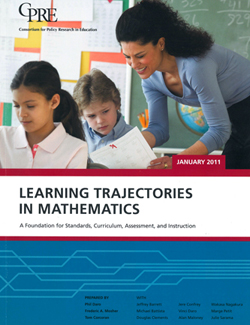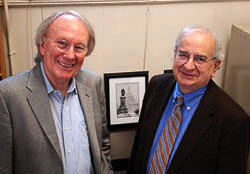Filed Under > Research/Publications
A Look at Learning Trajectories in Mathematics
A report finds new hope for better curriculum design and tools for teachers to monitor student progress toward learning standards.
A new report co-authored by Teachers College-based researchers focuses on the development of learning trajectories in K-12 mathematics.
Released by the Center on Continuous Instructional Improvement (CCII), a TC-based arm of the Consortium for Policy Research in Education (CPRE), the report, “Learning Trajectories in Mathematics: A Foundation for Standards, Curriculum, Assessment, and Instruction,” details current work and thinking in one of the most promising areas for improving K-12 mathematics education.
“Learning Trajectories in Mathematics” can be viewed and downloaded at www.ccii-cpre.org.
Teaching and learning trajectories – sometimes called learning progressions – are sequences of learning experiences hypothesized and designed to build a deep and increasingly sophisticated understanding of core concepts and practices within various disciplines. The trajectories are based on empirical evidence of how students’ understanding actually develops in response to instruction and where it might break down.
The new report “aims to provide a useful introduction to current work and thinking about learning trajectories for mathematics education; why we should care about these questions; and how to think about what is being attempted,” write the authors, Phil Daro, Frederic A. Mosher and Tom Corcoran.
Citing a recent study by ACT Inc., which found that among 11th grad students in five states, the percentage of all students who met ACT’s proxy for college ready standards ranged from just over 30 percent to just over 50 percent in key subjects – and as low as 10 percent for African American students on some standards -- the authors argue that it is “clear that instruction within schools will have to become much more responsive to the particular needs of the students they serve.” More specifically, “since students’ learning and their ability to meet ambitious standards in high school, builds over time – and takes time – if they are to have a reasonable chance to make it, their progress along the path to meeting those standards really has to be monitored purposefully, and action has to be taken whenever it is clear they are not making adequate progress.
While it is clear from current evidence that no single mathematics trajectory is appropriate for all students, “trajectories are useful as modal descriptions of the development of student thinking over shorter ranges of specific mathematical topics and instruction, and within particular cultural and curricular contexts.” Trajectories can also provide “a basis for informing teachers about the (sometimes wide) range of student understanding they are likely to encounter, and the kinds of pedagogical responses that are likely to help students move along.
The 79-page report includes sections on what learning trajectories are, trajectories and assessment, adapting trajectories to real-world practice, and the relationship between trajectories and the Common Core State Standards. The report also includes samples of learning trajectories and of a “multiplicative reasoning framework” developed by educators in Vermont. The authors make a number of recommendations, including that mathematics educators and funding agencies should recognize the importance of research on learning trajectories; that work should be done to consolidate existing learning trajectories; that studies should be undertaken of the development of students from different cultural backgrounds and with differing initial skill levels; and that investments should be made in development of assessment tools based on learning trajectories, for use by teachers and schools.
Phil Daro is a member of the lead writing team for the K-12 Common Core State Standards, senior fellow for Mathematics of America’s Choice, and director of the San Francisco Strategic Education Partnership maintained by UC Berkeley, Stanford and the San Francisco Unified School District. Frederic Mosher, a cognitive/social psychologist, is senior research consultant to CPRE. Tom Corcoran is co-director of CPRE at TC and principal investigator of CCII.
Established in 1985, CPRE unites research from seven of the nation’s leading research institutions in efforts to improve elementary and secondary education through practical research on policy, finance, school reform and school governance. The Consortium’s member institutions are Teachers College-Columbia University, the University of Pennsylvania, Harvard University, Stanford University, the University of Michigan, the University of Wisconsin-Madison, and Northwestern University.
CCII, launched by CPRE in 2006, engages in research and development on tools, processes and policies intended to promote the continuous improvement of instructional practice.
Published Friday, Mar. 11, 2011

